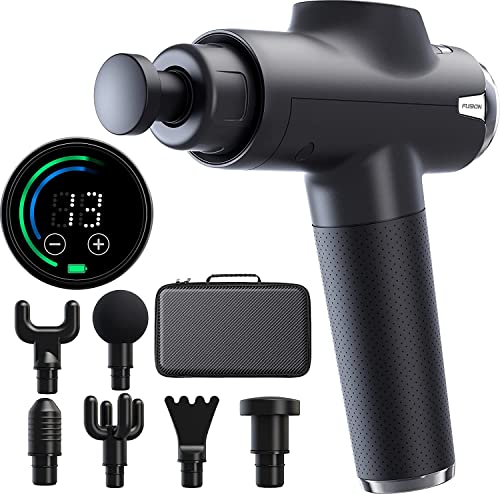In this post, I share the best massage gun for plantar fasciitis. See how percussion therapy can provide instant relief to a persistent problem, and get you back to your active lifestyle.

Have ever experienced plantar fasciitis? Yes, that throbbing stabbing pain on the bottom of your foot near the heel. If so, we can all agree it can often stand in the way of enjoying many of the activities we love to do!
Want to skip straight to the good stuff?
If your time is limited and you just want to purchase to best percussion massage gun for plantar fasciitis, here is the #1 Massage Gun I am currently recommending:
EKRIN Athletics B37 Massage Gun – Percussion Massager
➥Use this link to order directly from EKRIN and save an additional 20% when you enter my special discount code FF20!
Best Massage Gun for Plantar Fasciitis
What is plantar fasciitis?
One of the most common reasons for heel discomfort is plantar fasciitis. It is caused by inflammation of a broad band of tissue that links the heel bone to the toes on the bottom of each foot (plantar fascia).
What causes plantar fasciitis?
Some of the most common causes of plantar fasciitis include:
- Type of shoes
- Foot structure
- Overuse
- Types of walking surfaces
Is a massage gun good for treating plantar fasciitis?
Yes. A massage gun with high amplitude is excellent for a deep tissue massage, which is most likely to be effective for treating plantar fasciitis.
How it works to treat plantar fasciitis
- Stimulates blood flow
- Relax the condition of plantar fasciitis
- Promotes lymphatic drainage
- Breaks up inflammation in the tissue that runs across the bottom of the foot
Deep tissue massage is especially effective in loosening the tendons, ligaments, and fascia that have become painfully tight over time, relaxing them back into their normal posture.
10 Quick Plantar Fasciitis Treatments for Immediate Relief
1. Massage your feet
A simple self-massage can provide immediate relief from plantar fasciitis. Use your hands or a massage ball to apply pressure to the soles of your feet, focusing on the areas that feel tense or sore.
2. Apply an ice pack
Ice can help reduce inflammation and numb pain. Wrap an ice pack in a thin towel and apply it to the affected area for 15-20 minutes at a time.
3. Stretch the muscles of your feet
Regular foot stretches can ease tension and improve flexibility. Try stretching your foot by pulling your toes up towards your shin and holding for a few seconds.
4. Use toe separators
Toe separators can help correct foot alignment and alleviate pressure on your plantar fascia. Wear them for a few hours each day, gradually increasing the duration as comfort allows.
5. Try dry cupping
Dry cupping can increase blood flow and reduce inflammation. This therapy involves placing suction cups on the feet, though it’s recommended to seek professional guidance before trying at home.
6. Use sock splints at night and orthotics during the day
Sock splints worn at night can gently stretch your foot while you sleep, and orthotics can provide extra support during the day, relieving pressure and pain.
7. Try TENs Therapy
Transcutaneous Electrical Nerve Stimulation (TENS) therapy uses a low-voltage electrical current to relieve pain. A TENS unit can be used at home, but consult your doctor before starting this therapy.
8. Strengthen Your Feet with a washcloth
Grab a washcloth with your toes and release, repeating this several times a day. This simple exercise can strengthen your foot muscles and help alleviate plantar fasciitis pain.
9. Roll your feet with a foot massager roller
A foot massager roller can provide relief by applying concentrated pressure to your foot. Roll your foot over it for a few minutes daily, focusing on sore areas.
10. Stretch your feet with a textbook
Place a textbook on the floor and, while seated, rest your foot on it so that your toes hang over the edge. Gently pull your toes downwards for a stretch, then release. Repeat this several times a day.
$22.06 – Shop this product
While massage guns address muscle recovery, resistance bands can help strengthen the muscles that support your feet and reduce future plantar fasciitis risk.
FAQ
Will plantar fasciitis ever go away?
Yes. Without medical therapy, plantar fasciitis normally goes away in 6–18 months. However, it can develop into a persistent problem in some people. Symptoms may improve and then appear again, or the pain may remain consistent for a year or longer.
Does plantar fasciitis hurt all day?
During periods of sleep, you may experience throbbing or stabbing pain. As a result, if you don’t take steps to treat or alleviate your plantar fasciitis, you experience discomfort all day.
Is plantar fasciitis a form of arthritis?
Plantar fasciitis is a foot condition that is closely linked to rheumatoid arthritis. Some people who have one or both of these illnesses may be surprised by this. Roughly a quarter of Americans suffer from foot pain, which only becomes worse as they get older.
Why is plantar fasciitis so painful?
One of the most prevalent orthopedic ailments is plantar fasciitis. Plantar fascia ligaments are subjected to a great deal of wear and tear on a regular basis. The ligaments in your foot might be damaged or torn if you put too much pressure on them. When the plantar fascia gets inflamed, it produces heel discomfort and stiffness.
Does plantar fasciitis show up on x-ray?
No. In most cases, an x-ray is not required to diagnose plantar fasciitis since ligament damage is not visible with this procedure. X-rays are typically used to aid in the entire evaluation of the foot.
Does plantar fasciitis hurt to touch?
This is usually located in front of your heel and is tender to the touch. When you first get out of bed in the morning, or after long periods of rest with no weight on your foot, the pain is usually the worst. The pain is frequently described as stabbing or aching.
Does heat make plantar fasciitis worse?
Yes. Heat causes blood vessels to widen, allowing more blood to flow to the affected area. Heat should be used with caution if you have plantar fasciitis since it can cause swelling.
Does a tennis ball help plantar fasciitis?
Some people place a tennis ball on the ground and gently roll it underfoot for a few minutes to help loosen up your plantar fascia, making it much less likely to become irritated. This process can provide a good foot massage.
Can you make plantar fasciitis worse?
Yes. Your plantar fascia might be overworked if you apply pressure on your foot without sufficient arch support or padding. Wearing shoes that are overly tight or that raise your heel high above your toes can make the issue worse.
Is massage good for plantar fasciitis?
Yes. Deep tissue massage, in particular, is the treatment of choice for plantar fasciitis-related heel pain. Deep tissue massage is particularly beneficial because it loosens severely tight tendons, ligaments, and fascia, allowing them to relax back into their usual posture.
Can dehydration cause plantar fasciitis?
A lack of water affects almost every system and area of your body, including your plantar fascia. Dehydration can cause the lubricating fluid that protects tendons and ligaments from overuse injuries to decline.
Can plantar fasciitis cause your feet to swell?
Plantar fasciitis causes plenty of symptoms, the worst of which appear after extended periods of inactivity. For example, you might experience excruciating heel pain as soon as you get out of bed or stand up from your desk at work.
Does plantar fasciitis hurt while sleeping?
Inflammation and stiffness of the plantar fascia caused by overuse (or poor use) can cause severe nighttime foot pain. As your toes point during sleep, your plantar fascia may shorten, making the first step in the morning quite painful.
Can sitting cause plantar fasciitis?
Plantar fasciitis creates a stabbing pain near the heel on the bottom of your foot. The pain is normally the most severe when you take your first few steps after waking up, but it can also be caused by long periods of standing or getting up from a sitting position.
If you enjoyed, “Best Massage Gun for Plantar Fasciitis“, be sure to review my other related posts below.
Resources:
https://www.mayoclinic.org/diseases-conditions/plantar-fasciitis/symptoms-causes/syc-20354846
https://www.webmd.com/fitness-exercise/understanding-plantar-fasciitis-basics
https://www.hopkinsmedicine.org/health/conditions-and-diseases/plantar-fasciitis

Claudia Faucher is a full-time fitness training expert and lifestyle blogger. She is also been a certified Les Mills BodyPump instructor for the past 5 years and a fitness instructor for over 20 years. Claudia is a personal trainer and creates fitness training programs for seniors and people of all ages. She likes to use her skills and experiences to help others on their fitness journeys.
Last update on 2025-12-27 / Affiliate links / Images from Amazon Product Advertising API





